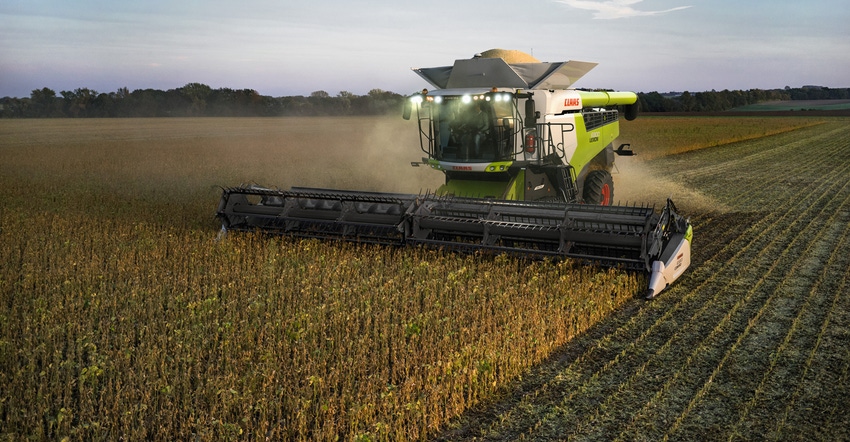June 26, 2020

Claas of America made a statement in 2019 with the launch of the new 7000 and 8000 Series combines. The new machines offered bigger grain tanks and a wide range of other features that fit with the competitive harvest market. And they are rotary-designed machines. But for some crops, especially in the Pacific Northwest and the Canadian Prairie, straw walkers are still preferred.
Claas answers with the new two-model 6000 Series line of straw walker combines.
During a virtual press event launching the new machines to the market, Patrick Arnold, product specialist, Claas of America, outlines some key features of the enhanced threshing system on the machines. “This is the only straw walker combine to offer an accelerator drum to balance crop flow and to optimize capacity of the threshing cylinder,” he points out. “The crop feeds more evenly into the threshing cylinder, even in wet harvest conditions, and produces higher centrifugal force for more effective separation.”
The new system is redesigned to include four cylinders for the crop to travel through on the way to the straw walkers. This helps even out the crop flow and provide higher capacity. Arnold says these new models will offer up to 25% more acres per hour than the predecessor Lexion 670.
A look at the threshing system shows four rolls in the system, yet a smooth flow from feeder house to walkers. Arnold notes during a walk-around that this design provides better grain flow with no “hills to climb” for grain moving through the system, compared to the competition. “[The system] provides smooth transition of the crop between cylinders in order to use less power and deliver less stress and twisting on the crop mat … which can deteriorate quality,” he notes.
Like its bigger brothers in the line, the 6000 Series comes outfitted with the automatic systems Claas is known for, including in-cab adjustments of items like the hydraulic concave blanking plate, or the hydraulic threshing concave flap.
That ability for precise adjustment and control during operation can make a difference. Greg Frenzel, product specialist, points to the CEMOS Automatic system that improves performance by autonomously making machine adjustments. “CEMOS Automatic allows operators to gain up to a 10% increase in machine throughput, get up to a 32% cleaner grain sample and improve grain retention by up to 58%, by continuously and autonomously making machine adjustments and optimizing machine performance,” he says.
Gentle on straw, faster on the road
One benefit of a straw-walker combine design is the quality of the straw off the back of the machine. Rotary machines do a great job of threshing; but if producers want to bale that straw, they may find it twisted, broken and not of very high quality. And there are markets that want to see quality straw.
The new Lexion 6000 provides a good mat of quality straw for growers to bale after harvest. Adds Frenzel: “While it may not be a main goal of your harvest, you can still count on high straw quality. The straight-line crop flow design of the threshing unit and the ability to fine-tune your threshing setting makes the Lexion 6000 Series the leader in straw quality, with an extremely high percentage of long, usable straw.”
Other key features for the new machine include a top road speed of 25 mph, which makes getting from field to field in those wide-open spaces more efficient. And Claas has been an industry leader in road speed for combines for some time. This speed is available for both wheeled and tracked models.
The machine also features quicker in-cab conversion between crops, reducing crop conversion time by up to 50%. And the new machines get the updated cab first introduced in the 7000 and 8000 Series machines. For example, you can change threshing speed, chopper speed and residue size control — all with a push button from the cab.
Maintenance and performance
The 6000 Series also features a central lubrication system, so 74 key points of lubrication always have the grease needed, saving you time. The daily maintenance routine is simpler, too, with no need to do a daily air filter maintenance. A short 20-minute machine clean-off time helps as well.
Airflow through the engine cooling system is pulled in from the top of the combine, where the air is cleanest. That flow also pushes down on dust and debris as the machine goes through the field, helping keep the machine cleaner.
One service Claas offers is the On Your Farm parts program. Turner Hagen, technical support specialist, notes: “Owners can customize a unique selection of parts for their machine to keep on their farm, and prevent downtime needed to drive to the dealership [for a part],” he says. The farmer only pays when a part is used, and that program allows farmers to keep needed daily maintenance items on hand, too.
There are two models: the Lexion 6800, with a 10.7-liter Mercedes engine providing 402 hp; and the Lexion 6900, with a 12.8-liter MAN engine with 466 hp. The machines feature what Claas calls “max power,” so that 6800 can move as high as 462 hp if needed in a short burst; for the 6900, the horsepower can climb to 507.
The machines also feature Dynamic Power, which optimizes power and fuel consumption. The company is claiming this power-fuel management approach can reduce fuel use as much as 31% over competitors, at the same time providing a power boost when unloading on the go.
Each of the machines has a 385-bushel grain tank standard, and there is an optional 425-bushel tank available. Auger unload speed can reach speeds up to 5.1 bushels per second. You can learn more about the new machine at claas.com.
About the Author(s)
You May Also Like






